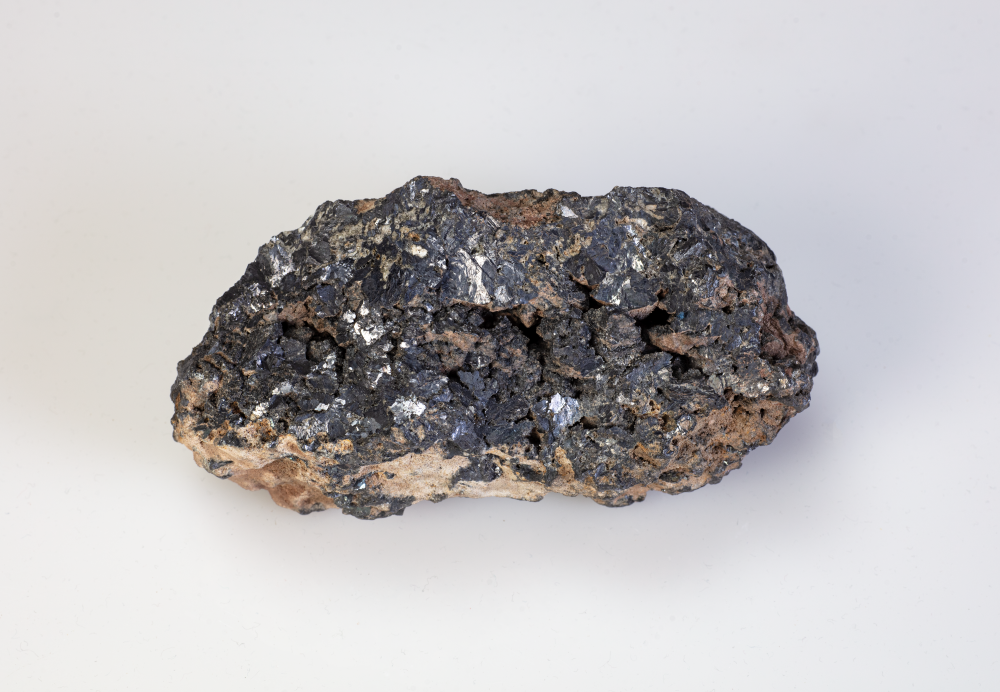Shepshed Cutting
Journey along a historic railway line, and discover the hidden geological treasures…

Lead ore from Shepshed Cutting. © The Natural History Museum, London
The Jubilee Path, which runs through Shepshed Cutting, occupies the route of the former Charnwood Forest Railway, and in places also the Charnwood Forest Canal.
In 1791 an Act of Parliament was passed that led to the formation of the Leicester Navigation Company. The aim was to re-establish the position of the West Leicestershire collieries who had faced considerable competition from South Derbyshire supplies following the completion of work in 1778 to make the River Soar navigable between South Derbyshire and Loughborough.
The Leicester Navigation Company built the Charnwood Forest Canal between the collieries in Thringstone and Loughborough, as well as making the River Soar navigable to Leicester, facilitating the sale of coal into the city. On 24th October 1794 a boat-load of coal was transported from Burslem’s colliery in Coleorton to Loughborough. However, this was an isolated early journey, as not all of the infrastructure had been completed. The feeder reservoir, on the site of the modern Blackbrook Reservoir, was completed in 1796. In 1799 the new reservoir burst, damaging the canal and property in the area. The reservoir was taken down in 1804 and the canal was abandoned.
The diary of Laura de Lisle, husband of Ambrose Lisle March Phillipps de Lisle, reveals that in 1865 prospecting for lead ore had begun in the former Charnwood Forest Canal cutting. Later in the year mining properly commenced at what was called the Tickow Lane Lead Mine. This small-scale mining operation likely only lasted for a few years. The diary of Laura de Lisle is held by Mount Saint Bernard’s Abbey.
In November 1866 Ambrose Lisle March Phillipps de Lisle presented a sample of the lead ore to the British Geological Survey. This specimen became part of the collections of the Institute of Geological Sciences, and is now in the Natural History Museum, London.
In 1881 the London and North Western Company began work to build a railway line from Shakerstone, through Coalville and Shepshed, to Loughborough. The line was opened on 16th April 1883. The Charnwood Forest Railway was built such that in places it occupied the same cutting made for the Charnwood Forest Canal. During construction the entrance to the former mine was likely buried. The Line closed to passengers in 1931, with freight services finishing in 1963.
In 1962 Prof Stephen Moorbath, University of Oxford, used the lead ore sample now in the Natural History Museum, London, as part of a geochemical study of UK lead minerals. The exact location of the mine was unknown. Investigations by a group of geologists in 1967 and 1968 led to the discovery of the lead mine immediately to the west of the Tickow Lane bridge, in the southern embankment. Their work revealed that the lead ore is very unusual in that it does not appear to have formed in the same way as other known lead ores. The entrance to the former mine remains buried to protect the site.
Recognising the site of the former lead miner, the land directly to the west of the Tickow Lane bridge has been designated as the Shepshed Cutting Site of Special Scientific Interest (SSSI). Established in 1981, this SSSI recognises the unique mineral deposits found in the former Tickow Lane Lead Mine. The citation from Natural England states that “The site is of international importance for developing a better understanding of the origins of mineral deposits and the processes which form them”.
The photo is of the original specimen of lead ore, originally presented by Ambrose de Lisle to the British Geological Survey. We are grateful to the Natural History Museum, London, for arranging this photograph to be taken and sharing it with the Geopark. © The Natural History Museum, London
An interpretation panel is located on the Tickow Lane bridge at What3words location ///intruding.powering.bliss
The image at the top of the page shows Bob King within the lead mine. It was take by Franz Werner.